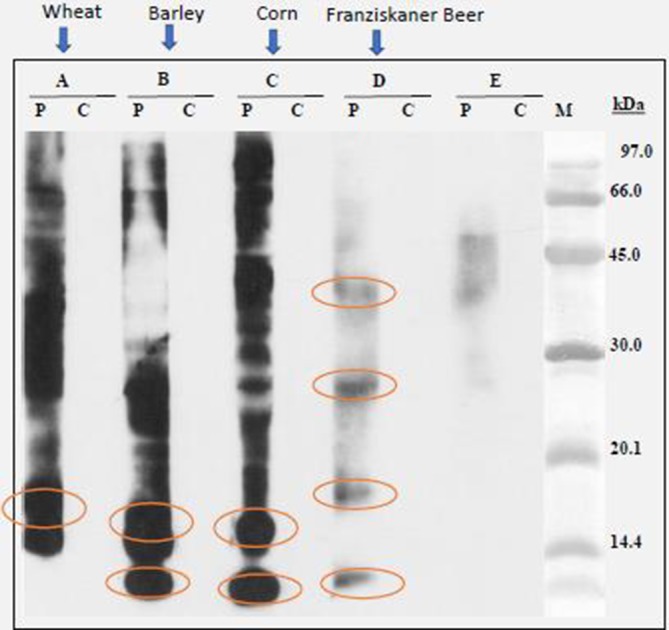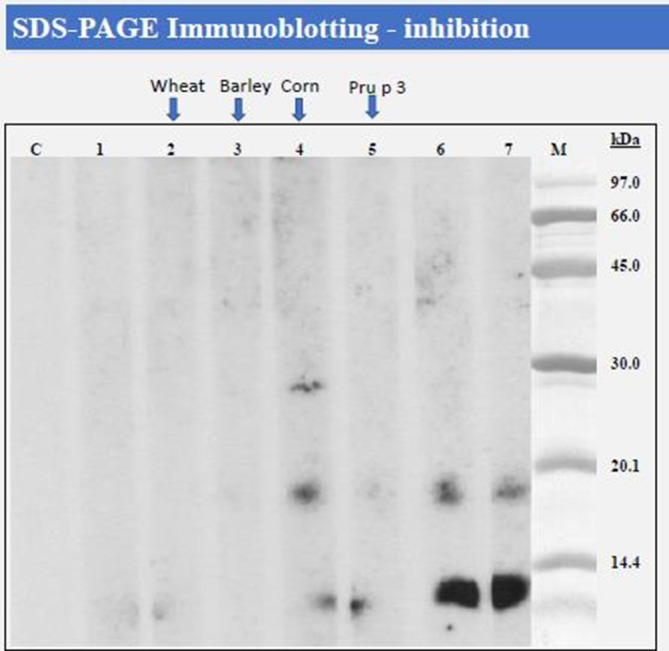Abstract
Beer is one of the most consumed alcoholic beverages worldwide but allergic reactions to this beverage are uncommon. The authors present a case report of a 32-year-old male patient, sent to our Allergy and Immunology Department due to anaphylaxis minutes after Franziskaner beer ingestion. He tolerates all other alcoholic beverages. Prick tests to cereals were positive to wheat, corn and barley, as well as to peach. Prick-to-prick tests were performed with nine beer brands, all positive. Immunoglobulin (Ig)E to Pru p 3 was 14.8 kU/L. Sodium dodecyl sulfate polyacrylamide gel electrophoresis inhibition immunoblotting was performed with the Franziskaner beer extract in solid phase and both cereal extracts (wheat, barley and corn) and Pru p 3 as inhibitors. Extracts from wheat, barley and corn, and Pru p 3 purified protein were able to inhibit almost totally the IgE-binding to the Franziskaner beer extract. It seemed likely that the IgE-binding bands detected in the Franziskaner beer extract could be an LTP from cereals.
Keywords: immunology, medical management
Background
Immunoglobulin (Ig)E-mediated reactions to beer are rare. Sensitisation to non-specific lipid-transfer proteins (nsLTPs) is a risk factor for systemic allergic reactions, although symptoms restricted to the oropharynx can also occur. Our case describes a patient sensitised to nsLTPs who developed anaphylaxis minutes after drinking beer. He also had an episode of throat tightness after the ingestion of a poorly cooked wheat bread with seeds. Prick tests were positive to wheat, corn, barley and peach. Prick-to-prick tests to all nine beers tested were positive. The authors performed sodium dodecyl sulfate polyacrylamide gel electrophoresis (SDS-PAGE) inhibition immunoblotting assay, with the Franziskaner beer extract in solid phase and cereal extracts (wheat, barley and corn) and Pru p 3 as inhibitors.
Extracts from wheat, barley and corn, and Pru p three purified protein were able to inhibit almost totally the IgE-binding to the Franziskaner beer extract. According to these results, it seemed very likely that the IgE-binding bands detected in the Franziskaner beer extract could be the nsLTP protein in different states of aggregation. In this specific case, we have a patient who is sensitised to LTP and had anaphylaxis with beer, probably due to alcohol as a cofactor. It is important to know that even patients who tolerate peach and well-cooked bread may have a serious allergic reaction when exposed to cofactors.
Case presentation
Beer is one of the most consumed alcoholic beverages worldwide.1 In its production, malt, hops, brewer’s yeast and water are generally used, but in some beers, other cereals can be included.1 Malt is the basic ingredient used in brewing, and it derives from germinated barley. Therefore, beer polypeptides have their origin mainly in barley proteins, either partially modified or as products of proteolytic or chemical modifications involved in barley’s processing,2 and they could also proceed from some other cereals (wheat, corn) sometimes added during the beer production process. Hops (Humulus lupulus) provide bitterness and contribute to beer preservation. For fermentation, two yeasts are used: Saccharomyces cerevisiae and Saccharomyces carlsbergensis. IgE-immediate reactions to beer are uncommon. There are few cases in literature describing beer-induced anaphylaxis.1 3–7
The authors present a case report of a 32 - year old male patient, sent to our Allergy and Immunology Department due to anaphylaxis minutes after beer ingestion. Symptoms began at 17 years of age, when some minutes (15–20 min) after drinking a beer he initiated dyspnoea, thoracic oppression, wheezing, throat tightness, generalised urticaria and lip angioedema. The patient reported repeated beer ingestion of several beer brands in smaller quantities, with similar symptoms. Last reported reaction occurred immediately after lip contact with the bottle which triggered lip pruritus and throat tightness. He tolerates cooked beer in foods and all other alcoholic beverages. At 32 years of age, he developed throat tightness after the ingestion of a poorly cooked wheat bread with seeds. He tolerates every other type of well-cooked bread. He started avoidance of beer and poorly cooked wheat bread with no new allergy episodes. Concerning personal history, there was no history of rhinitis, asthma or other diseases. No daily medication. No family history of atopy.
The patient was submitted to prick-to-prick tests to nine beer brands, prick tests to extracts from cereals (wheat, barley, corn), peach, Humulus lupulus and S. cerevisiae; serum-specific IgE determinations to Pru p 3 and SDS-PAGE immunoblotting. Prick-to-prick tests were performed in our patient and in five atopic controls (with rhinitis with/without asthma). Prick-to-prick tests to the tested beer brands were all negative in our five controls. They were performed by applying 1 drop of each beer brand in the forearm and pricking with a standardised lancet. Positive results were assumed when the resultant papule had a diameter of ≥3 mm.
Prick tests and prick-to-prick tests results are described in table 1.
Table 1.
Skin prick tests, IgE and prick-to-prick tests results
| Skin prick tests | Papule (mm) | Specific IgE (kU/L) |
| Histamine | 3 | – |
| Wheat | 3 | Not performed |
| Corn | 5 | Not performed |
| Barley | 4 | Not performed |
| Pru p 3 | 4 | 14.8 |
| S. cerevisiae | Neg | Not available |
| H. lupulus | Neg | Not available |
| Prick-to-prick tests | Papule (mm) | |
| Sagres | 5 | |
| Black Sagres | 4 | |
| Sagres Radler | 4 | |
| Heineken | 4 | |
| Cristal | 5 | |
| Super Bock | 5 | |
| Imperial | 5 | |
| Carlsberg | 5 | |
| Franziskaner | 3 |
H. lupulus, Humulus lupulus; IgE, immunoglobulin E; S. cerevisiae, Saccharomyces cerevisiae.
We studied the presence of serum-specific IgE against proteins from two beer brands (Hofbrau—wheat white beer, Franziskaner—wheat black beer) and three types of cereal (wheat, barley and corn). This was performed by means of SDS-PAGE immunoblotting according to Laemmli, in electrophoretic reducing conditions (with 2-mercaptoethanol).
The immunoblotting study revealed an intense IgE-binding band of 15–16 kDa in the wheat extract, and two bands in barley and corn extracts, of 15 and 9 kDa bands, respectively.
In the Franziskaner beer extract, IgE-binding bands of 40, 28, 18 and 9 kDa were detected (figure 1). Considering that beer is produced with several kinds cereals with nsLTP (wheat—Tri a 14, barley—Hor v 149) and that this patient is sensitised to LTP, it seems probable that the beer 9 kDa IgE-binding band could be an LTP. Serum-specific IgE against Pru p 3 was determined by means of EAST technique, with a value of 14.8 kUA/L. Cross-reactivity was studied using an SDS-PAGE inhibition immunoblotting assay, with the Franziskaner beer extract in solid phase and cereal extracts (wheat, barley and corn) and Pru p 3 as inhibitors (figure 2).
Figure 1.

SDS-PAGE IgE-Immunoblotting results. (A) Wheat extract. (B) Barley extract. (C) Corn extract. (D) Franziskaner beer extract. (E) Hofbrau beer extract. Lane P is patient serum, lane C is control serum (pool of non-atopic subject sera) and lane M is molecular mass marker. IgE, immunoglobulin E; SDS-PAGE, s odium dodecyl sulfate polyacrylamide gel electrophoresis.
Figure 2.

IgE immunoblotting-inhibition results. Solid phases: Franziskaner beer extract. Lane C: control serum (pool of non atopic subject sera). Lanes 1–7: patient serum previously incubated with the Franziskaner beer extract (lane 1), with wheat extract (lane 2), with barley extract (lane 3), with corn extract (lane 4), with Pru p 3 (lane 5), with BSA (lane 6), with lamb extract (lane 7). Lane M: molecular mass marker. IgE, immunoglobulin E; SDS-PAGE, s odium dodecyl sulfate polyacrylamide gel electrophoresis.
Extracts from wheat, barley and corn, and Pru p 3 purified protein were able to inhibit almost totally the IgE-binding to the Franziskaner beer extract.
According to these results, it seemed very likely that the IgE-binding bands detected in the Franziskaner beer extract could be the nsLTP protein in different states of aggregation. We detected patient serum-specific IgE against proteins from the Franziskaner beer extract, which justifies an allergic reaction following beer ingestion. According to the obtained in vitro results, we assume that the sensitisation to cereal nsLTP is the cause of the beer allergy reaction. NsLTPs are small molecules of approximately 9 kDa that belong to a family of structurally highly conserved proteins present in a broad spectrum of fruits and vegetables. They represent the major allergens in the Rosaceae subfamilies of the Prunoideae (peach, apricot, cherry, plum) and of the Pomoideae (apple).8
This study shows that our patient had anaphylactic episodes following beer ingestion surely due to nsLTP-hypersensitivity. Barley’s nsLTP, Hor v 14, has been detected in beer.9 It resists heat and brewing, which translates in persistent allergenicity. These physicochemical characteristics are probably the reason why nsLTP-sensitive patients frequently experience systemic allergic reactions following ingestion of nsLTP-containing foods.
Our final aim with this work is to demonstrate that nsLTP is a relevant beer allergen, and it may cross-react with nsLTPs from several other plant-derived foods. Furthermore, we can actually speculate that being an alcoholic beverage, beer allergens absorption is enhanced, contributing to a faster and more severe reaction. Therefore, nsLTP-sensitised patients, especially cereal nsLTP-sensitised patients, should be alerted to allergic reactions after beer ingestion.
Outcome and follow-up
The patient maintains avoidance of beer and poorly cooked bread. He had no new episodes of anaphylaxis and he denies symptoms after eating cereals and peach, as well as other Rosaceae. Many patients with sIgE reactivity to nsLTPs do not have clinical symptoms when exposed to the respective plant food.
Discussion
There are few cases in literature describing beer-induced anaphylaxis.1 3–7 The majority of the cited case reports identify nsLTPs as the culprit allergen in beer allergy/anaphylaxis.
Learning points.
Lipid-transfer protein (LTP) is a major allergen in beer.
Alcohol is an important cofactor in this case report and enhances allergen absorption.
Patients sensitised to non-specific LTPs should be alerted to the fact that they can have an allergic reaction when exposed to beer.
Footnotes
Contributors: JSP: wrote the case report; NS: oriented the patient; performed the clinical history, skin prick tests and prick-to-prick tests to all beers. BB: performed the analysis through immunoblotting. CL and ATB: review and final corrections.
Funding: The authors have not declared a specific grant for this research from any funding agency in the public, commercial or not-for-profit sectors.
Competing interests: None declared.
Patient consent: Obtained.
Provenance and peer review: Not commissioned; externally peer reviewed.
References
- 1. Quercia O, Zoccatelli G, Stefanini GF, et al. Allergy to beer in LTP-sensitized patients: beers are not all the same. Allergy 2012;67:1186–9. 10.1111/j.1398-9995.2012.02872.x [DOI] [PubMed] [Google Scholar]
- 2. García-Casado G, Crespo JF, Rodríguez J, et al. Isolation and characterization of barley lipid transfer protein and protein Z as beer allergens. J Allergy Clin Immunol 2001;108:647–9. [DOI] [PubMed] [Google Scholar]
- 3. Nusem D, Panasoff J. Beer anaphylaxis. Isr Med Assoc J 2009;11:380–1. [PubMed] [Google Scholar]
- 4. Herzinger T, Kick G, Ludolph-Hauser D, et al. Anaphylaxis to wheat beer. Ann Allergy Asthma Immunol 2004;92:673–5. 10.1016/S1081-1206(10)61436-6 [DOI] [PubMed] [Google Scholar]
- 5. Figueredo E, Quirce S, del Amo A, et al. Beer-induced anaphylaxis: identification of allergens. Allergy 1999;54:630–4. [DOI] [PubMed] [Google Scholar]
- 6. Fernández-Anaya S, Crespo JF, Rodríguez JR, et al. Beer anaphylaxis. J Allergy Clin Immunol 1999;103(5 Pt 1):959–60. [DOI] [PubMed] [Google Scholar]
- 7. Bonadonna P, Crivellaro M, Dama A, et al. Beer-induced anaphylaxis due to barley sensitization: two case reports. J Investig Allergol Clin Immunol 1999;9:268–70. [PubMed] [Google Scholar]
- 8. Asero R, Mistrello G, Roncarolo D, et al. A case of allergy to beer showing cross-reactivity between lipid transfer proteins. Ann Allergy Asthma Immunol 2001;87:65–7. 10.1016/S1081-1206(10)62325-3 [DOI] [PubMed] [Google Scholar]
- 9. Picariello G, Mamone G, Cutignano A, et al. Proteomics, peptidomics, and immunogenic potential of wheat beer (Weissbier). J Agric Food Chem 2015;63:3579–86. 10.1021/acs.jafc.5b00631 [DOI] [PubMed] [Google Scholar]


